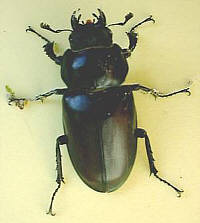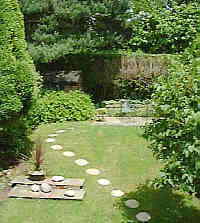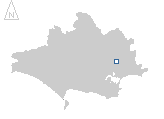Stag Beetles, Wimborne, May – June
The Stag Beetle (Lucanus cervus) is the largest beetle in Britain, reaching up to 50mm in length. Once common over much of southern England and Wales, they are now very scarce outside of the Thames Valley, southern East Anglia and the New Forest. The same picture applies across most of Europe, with most countries reporting few sightings ( find out more ).
In an attempt to map the current distribution of the beetle a national survey of sightings was carried out in 1998 as part of the stag beetle Biodiversity Action Plan. Several interested parties supported the survey, the lead partner being the People's Trust for Endangered Species ( find out more ). Preliminary results from the survey confirm that Wimborne is one of the few areas where there have still been numerous sightings.
 |
 |
| Female – measuring 36mm in length (excluding the mandibles) |
Location where stag beetles were photographed and recorded |
 Photographs
Photographs
The pictures on these pages were taken between late May and the end of June, the main period during which the Stag Beetles appear here in Wimborne. All sightings were in the one garden, a small patch of grass and shrubs (shown above) in a residential area. The beetles have clearly been able to adapt to the variety of trees and shrubs that can be found in this urban habitat – and have been observed using the privet hedge (which runs along the upper edge of the garden) for mating.
Some notes on the photographs
The majority of the photographs were taken using the macro setting on the digital camera. The closeup pictures of the male and female mandibles were achieved by using a supplemental lens (e.g. small hand-lens) placed infront of the camera's own lens.
In all cases the photographs are of live specimens, the natural reaction of the beetle to an approaching large object is to remain motionless – making it a well behaved candidate for close-up photography.
The mating pair shown were seen hanging almost motionless for over two hours. They hung suspended from a hole in a leaf, with the female taking all of the weight of the pair through just one leg.
The camera used had a lens with a relatively wide angle of view, which was also fixed, hence attempting to take photographs of the beetles in flight was very much a 'hit or miss' process. The results so far have generally been 'miss', the very blurred image resulted from the beetle attempting to land on the camera whilst it was being held aloft!
Sounds of the beetle
The large size of the beetle means that they have a relatively slow wingbeat in comparison to other insects found in the UK. The trace below shows the shape of the sound waves recorded as a large male (approximately 45mm long, excluding the mandibles) approached and hovered around a microphone held aloft. There are two frequencies present; the main peaks – at 28ms intervals – giving a loud 36Hz thrumming sound, smaller intermediate peaks giving a quieter 72Hz buzz.
Towards the end of June – when the evenings are warm and still – the males 'cruise' around the trees and bushes, flying slowly, sometimes hanging almost stationary in a hover, sniffing out a mate. When holding up the small compact camera in 1999 a male descended onto the camera to investigate (photo), the same reaction was observed again when in 2001 a microphone was held up high – the slow moving, small darkish object must have appeared a prospective mate and was duly landed on and inspected – hear what it sounds like (sample is 8.38 seconds duration, 181KB filesize) to have a stag beetle descend on you! The sound may be scary but please always remember – Stag Beetles do not sting or bite.

